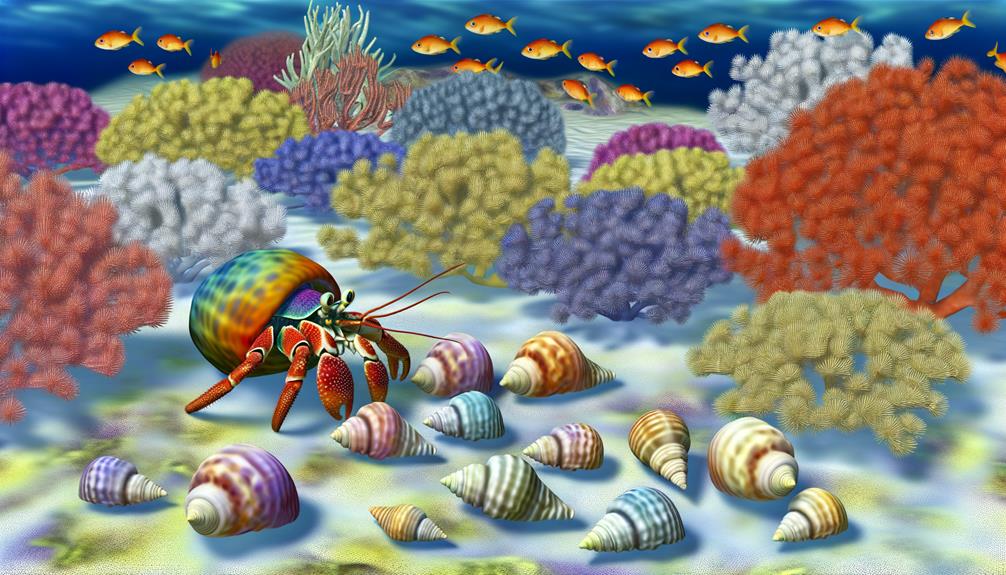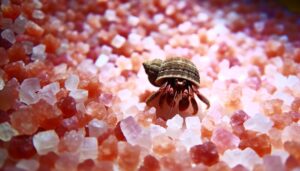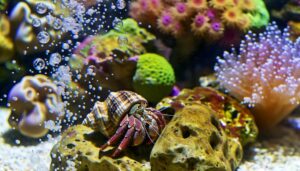Do Hermit Crabs Shed Their Skin?
Yes, hermit crabs do outgrow their shells as they develop through molting and cellular expansion. Ecdysis, or the shedding process, is frequent in juveniles and less so in adults.
If a hermit crab's abdomen protrudes from its shell or its mobility is restricted, it's likely seeking a larger home. They evaluate new shells based on size, weight, and structural integrity to ensure best protection and mobility.
A decrease in shell availability due to pollution and overharvesting aggravates their need for suitable shells. Conservation efforts are essential for maintaining hermit crab populations.
Stick around to gain more insights into their fascinating growth and survival strategies.

Key Takeaways
- Hermit crabs outgrow their shells as they molt and expand their bodies.
- Juvenile hermit crabs molt frequently and require new, larger shells more often.
- Protruding abdomen and restricted mobility indicate that a hermit crab has outgrown its shell.
- Behavioral changes, such as increased shell-checking, signal the need for a larger shell.
- Suitable shell availability is crucial for hermit crab growth and survival.
Hermit Crab Growth
Hermit crab growth, driven by molting and cellular expansion, requires periodic relocation to larger shells. During molting, hermit crabs undergo ecdysis, where they shed their exoskeleton to allow for somatic growth.
The molting cycle, influenced by environmental factors and nutritional intake, is vital for their survival. Research indicates that juvenile crabs molt every few weeks, while adults molt less frequently, approximately every 12 to 18 months.
Cellular expansion follows, where osmoregulation aids in the uptake of water, increasing body volume. This sequential process secures hermit crabs' structural integrity and metabolic efficiency.
Shell Selection Process
Selecting a new shell is an important behavior influenced by the hermit crab's size, shell availability, and environmental conditions. Extensive research has shown that hermit crabs evaluate potential shells based on several criteria to ensure ideal protection and mobility.
When observing shell selection, you'll notice specific behaviors:
- Shell Fit: Hermit crabs measure potential shells to ensure they're roomy enough for future growth but not too heavy to hinder movement.
- Shell Condition: They prefer shells free of cracks or damage, as these flaws can compromise their safety.
- Weight: The shell's weight is essential; too heavy, and it impedes movement, too light, and it offers inadequate protection.
- Aperture Size: The opening must be the right size to allow easy entry and exit while providing security against predators.
Signs of Outgrowing Shells
When observing hermit crabs, you'll notice that a shell size discrepancy often indicates outgrowth, characterized by the crab's body extending beyond the shell's opening.
Behavioral changes such as increased frequency in shell-checking and decreased activity levels are significant indicators.
Research shows these signs correlate strongly with the need for a new, larger shell.
Shell Size Discrepancy
Observing a significant increase in the hermit crab's body mass compared to its shell indicates that the crab is outgrowing its current abode. It's essential to recognize specific signs of shell size discrepancy to guarantee the hermit crab's well-being. Research highlights four observable indicators:
- Protruding Abdomen: The crab's abdomen extends beyond the shell's opening, exposing it to potential harm.
- Restricted Mobility: The crab struggles to retract fully into the shell, compromising its defense mechanisms.
- Increased Shell Wear: Excessive wear and tear on the shell's opening due to the crab's larger body size.
- Frequent Shell Switching: The crab frequently switches shells, indicating discomfort and the urgent need for a larger shell.
Behavioral Changes Observed
Hermit crabs exhibit noticeable behavioral changes such as increased activity and agitation, signaling they may be outgrowing their current shells. You might observe your hermit crabs repeatedly leaving and re-entering their shells, indicating discomfort.
Scientific data show that hermit crabs spend more time exploring their environment when they're seeking larger shells. Studies have documented elevated levels of aggression as they compete for suitable new shells.
Monitoring these behaviors can aid you in timely interventions, such as providing a range of appropriately sized shells. By understanding and responding to these signs, you'll make sure the well-being and growth of your hermit crabs, ultimately maintaining a healthier ecosystem for them.
Finding New Homes
As hermit crabs grow, they meticulously search for larger shells to accommodate their increasing size, often competing with others for the most suitable options. This process is critical for their survival, requiring them to constantly evaluate potential new homes.
Research indicates that hermit crabs employ specific criteria when selecting new shells:
- Shell Size: Crabs assess internal volume to guarantee adequate space.
- Shell Weight: They prefer lighter shells for ease of movement.
- Shell Aperture Width: The opening must be wide enough for easy entry.
- Shell Condition: Crabs avoid damaged shells that could jeopardize protection.
Through these criteria, hermit crabs demonstrate remarkable adaptability and resourcefulness, ensuring they remain well-protected as they grow.
Your understanding of these behaviors can promote better conservation practices, aiding in their preservation.
Shell Availability Issues
Due to environmental changes and human activities, the availability of suitable shells for hermit crabs has greatly diminished, posing a critical threat to their survival. Research indicates that pollution, particularly plastic waste, has disrupted marine ecosystems, reducing the number of gastropod shells that hermit crabs rely on.
Studies show a 30% decline in shell availability in some regions. Additionally, overharvesting of shells for the souvenir trade exacerbates the crisis, leaving hermit crabs vulnerable to predation and environmental stress.
You can help mitigate this issue through conservation efforts, advocating for reduced plastic use, and supporting sustainable tourism. By addressing these factors, you'll contribute to a more stable environment for hermit crabs and other marine organisms.
Competition for Shells
You'll find that limited shell availability heightens competition among hermit crabs, leading to aggressive shell fights documented in multiple studies.
Research shows that these crabs employ various shell theft strategies, including evicting weaker crabs.
Data indicates that such competition can impact their survival and reproductive success to a great extent.
Limited Shell Availability
How does the scarcity of suitable shells impact hermit crab populations and drive intense competition for resources? Limited shell availability can influence hermit crab survival and behavior. When shells are scarce, hermit crabs face increased stress and reduced growth rates, leading to population declines. Researchers have observed several critical impacts:
- Mortality Rates: Higher mortality due to lack of adequate protection.
- Growth Inhibition: Stunted growth resulting from staying in undersized shells.
- Reproductive Success: Decreased reproductive rates as energy is diverted from reproduction to survival.
- Migration: Increased migration in search of suitable shells, exposing crabs to predators.
Aggressive Shell Fights
As shell availability dwindles, hermit crabs engage in aggressive shell fights, intensifying competition and influencing population dynamics. These confrontations often involve physical pushing and shell rapping, where crabs strike their shells against each other.
Research shows that larger crabs typically dominate these encounters, securing superior shells and enhancing their survival prospects. In some populations, up to 30% of hermit crabs experience shell fights, leading to a significant impact on community structure.
Data indicates that hermit crabs without best-fit shells exhibit lower reproductive success and increased vulnerability to predators. Understanding these dynamics helps in conservation efforts, emphasizing the importance of maintaining shell availability to support hermit crab populations and, by extension, the ecosystems they inhabit.
Shell Theft Strategies
Although hermit crabs often engage in direct confrontations for shells, they also employ strategic shell theft, which involves waiting for opportune moments to seize an unguarded or poorly defended shell.
Research indicates that hermit crabs exhibit patience and cunning in their quest for best-fit shells, often using observational tactics and timing their moves carefully. Here are four key strategies they use:
- Scouting: They monitor potential targets for vulnerabilities.
- Opportunistic Replacement: They wait for a crab to temporarily leave its shell.
- Mobility Monitoring: They observe the movement of the target, striking when it's less nimble.
- Group Dynamics: Occasionally, crabs form temporary alliances to evict another crab out of its shell.
These behaviors highlight the complex social interactions and competition among hermit crabs for essential resources.
Impact of Shell Size
The size of a hermit crab's shell directly influences its growth rate, reproductive success, and overall survival, according to recent studies. Shells that are too small restrict the crab's ability to grow and can lead to increased mortality rates.
Data indicates that best shell size enhances not only the crab's physical development but also its reproductive potential. Crabs in appropriately sized shells exhibit higher fecundity, as larger shells provide better protection and more space for egg carrying. Additionally, larger shells reduce predation risk, thereby enhancing survival probabilities.
Research shows that hermit crabs in ideal shells have a 20% higher survival rate. By ensuring that hermit crabs have access to suitable shells, you can have a significant impact on their longevity and well-being.
Social Behaviors
You'll observe that hermit crabs exhibit complex social behaviors, particularly during group shell exchanges, which are necessary for their survival.
Research shows that these exchanges involve intricate communication and are influenced by a hierarchical structure within the group.
Studies indicate that larger crabs often initiate the process, setting a chain reaction of shell swapping that benefits the entire community.
Group Shell Exchanges
Researchers have observed that hermit crabs engage in synchronized group shell exchanges, a social behavior that optimizes shell fit and reduces predation risk. This process involves multiple individuals gathering and exchanging shells in a highly organized manner. Studies show that these exchanges enhance survival rates by ensuring that each crab finds a shell that perfectly matches its size.
Here's how you can visualize the group shell exchange process:
- Gathering Phase: Hermit crabs assemble in a single location.
- Assessment Phase: Each crab evaluates available shells.
- Exchange Phase: Crabs line up from largest to smallest.
- Acquisition Phase: Sequentially, each crab moves into a new shell.
These coordinated efforts demonstrate hermit crabs' remarkable social behaviors, emphasizing the importance of community and cooperation within the species.
Communication and Hierarchy
Hermit crabs' elaborate social hierarchy relies on effective communication, facilitating organized interactions during shell exchanges and other communal activities. Research indicates that hermit crabs utilize a range of tactile and chemical signals to convey their status and intentions.
For instance, shell rapping—a behavior where a crab taps its shell against another's—serves as an essential signal during shell fights or negotiations. Studies have shown that higher-ranking crabs often initiate these interactions, indicating dominance.
Additionally, chemical cues released into the environment help you assess potential threats or opportunities. Understanding these communication pathways is crucial for ensuring hermit crabs' well-being in both natural and controlled environments. By recognizing these behaviors, you can better support their social structures and overall health.
Environmental Pressures
Environmental pressures, such as fluctuating temperatures and limited resources, impact the growth and survival of hermit crabs in their natural habitats. These factors create a challenging environment for hermit crabs, influencing their need to outgrow and find new shells.
Research data highlights four main environmental pressures:
- Temperature Variability: Sudden changes can stress hermit crabs, affecting their metabolic rates.
- Food Scarcity: Limited availability of food sources reduces growth rates and can lead to malnutrition.
- Predation: Increased predator presence forces hermit crabs to frequently seek new, more secure shells.
- Habitat Degradation: Deterioration of natural habitats due to climate change and natural disasters reduces the availability of suitable shells.
Human Influence
Due to human activities such as coastal development and pollution, hermit crabs face increased challenges in finding suitable shells, exacerbating their survival pressures. Research indicates that plastic debris mimics natural shells, misleading hermit crabs into inhabiting unsuitable, often harmful materials.
Studies show a 40% decline in gastropod populations, reducing natural shell availability. Data from coastal surveys highlight a 60% rise in beach litter, correlating with a significant drop in viable shell habitats. Your understanding of these impacts can guide better coastal management practices.
Realizing the anthropogenic effects on hermit crabs underscores the importance of responsible behavior. By mitigating pollution and development pressures, you contribute to preserving their ecosystems and ensuring these creatures find appropriate homes.
Conservation Efforts
To combat the decline in suitable shells for hermit crabs, conservation efforts focus on habitat restoration and reducing marine pollution through targeted clean-up initiatives and stricter environmental regulations. By restoring their natural habitats and implementing sustainable practices, you can help guarantee a future for these creatures.
Consider supporting these efforts:
- Habitat Restoration Projects: Participate in coastal clean-up events to remove debris and restore natural habitats.
- Marine Pollution Reduction: Advocate for stricter regulations on plastic waste and chemical runoff to protect marine ecosystems.
- Shell Donation Programs: Donate or recycle shells to provide appropriate homes for hermit crabs.
- Research and Education: Support scientific research and educational programs to raise awareness about the importance of marine conservation.
Your involvement can make a significant impact.
Conclusion
In your journey to understand hermit crabs, you've uncovered the delicate dance of growth and adaptation.
When hermit crabs 'upgrade' their shells, it's not just about size—it's survival.
Limited shell availability and environmental changes create challenges, but these resilient creatures persist.
Your role in conservation can make a difference. By supporting habitat protection and reducing human impact, you contribute to the well-being of these remarkable, resourceful animals.
Science shows us that every action counts.






